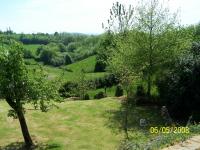
Rural Tranquility

Rural Tranquility
Lower Normandy, the Bocage, Manche and Calvados
The many war cemeteries are moving, commemorating both World Wars and soldiers, sailors and airmen from both sides. The German cemetery at Orglandes on the way to Cherbourg is vast and beautifully kept. Private Harry Neave from Sixpenny Handley is buried in the allied cemetery at St Manvieu-Norrey near Bayeux, along with many comrades from the Dorset, Devonshire and Wiltshire Regiments.
Avranches, which is the closest main town to the house, is where the Americans under General Paton finally broke through the German lines. He was able to force his way through to attack Paris from the South, whilst the rest of the allies attacked from the North and West. There is a memorial to him in Place Paton in Avranches, complete with a genuine Sherman Tank in the middle - pay your due respects !
Places of interest
| Avranches | Nearest main town. Attractive, lots of shops. Fabulous views of le Mont St Michel from the park in front of the Sous Préfacture. Castle. Tourist office. |
| Bayeux | Famous Bayeux tapestry. Well worth a visit on the way back to Cherbourg to catch the ferry. The story of William the Conqueror. |
| Brécey | Nearest town. Coccinelle supermarket at the bottom of the square. Cheapest petrol. Market on Friday morning, well worth a visit. Plenty of boulangeries, patisseries, charcuterie. |
| Clécy | The centre of the Suisse Normande |
| Coulouvray Boisbenâtre | The neighbouring village to the house and the back road to Villedieu. Nice bike rides, but hard work. Turn right out of the farm road. At the cross roads after a mile, turn left. Turn left at the next cross roads and continue to Les Hauts to St Laurent de Cuves. Alternatively, turn right into "Rue d'Etang" which will take you to a mill pond.Alternatively again, at the first cross roads, turn right and walk along the lane and farm tracks, eventually circling back left to where you started. |
| Coutances | Spectacular view of Coutances Cathedral as you approach from the South. |
| Dinan | Brittany, near St Malo. Old mediaeval town. |
| Domfront | HQ of the SS during the second World War. |
| Flers | Road to Suisse Normand |
| Fougeres | Interesting town |
| Granville | Fashionable seaside resort for Parisiennes. The area around the church up on the hill is nice. |
| Hambye | Abbey Very old mediaeval abbey in glorious countryside and well worth a visit |
| Jullouville | Sea bathing |
| La Baleine | Close to Hambye Abbey with spectacular countryside and hills |
| le Mont St Michel | Island cathedral in the bay joined by a causeway which floods at high tide. Impressive but a tourist trap. |
| Moulin de Jean | Wonderful old mill country restaurant. 3 course haute cuisine meal for £17. Turn left out of the farm road, go straight cross the main Brécey > St Pois road. Keep going for about 3 miles until you reach the village of Cuves (not to be confused with St Laurent de Cuves). Turn left and take first turning (D48) on the left back towards St Pois. The Moulin de Jean is about a mile on the right. To reserve, telephone 02 33 48 39 29 and speak to Gaetin (he speaks English). |
| Normandy Beaches | Omaha, Sword, Juno. Exhibitions and just wide, open sand beaches with no protection whatsoever. Very humbling. |
| St Malo | Beautiful old walled city, badly damaged in the war but fully restored. It was from here that Jacques Cartier set out to settle French North America, from Quebec in Canada down the Mississippi to New Orleans. |
| St Sever | Small country town - nice drive through the St Sever Forest, which suffered much damage during the storms. |
| Villedieu | les Poelles Poelle means cooking pot in French. This is the centre of copper and you can visit the foundries to see bells being cast. Quite attractive. |
| Vire | Larger town with plenty of shops. Destroyed during the war but re-built tastefully. |